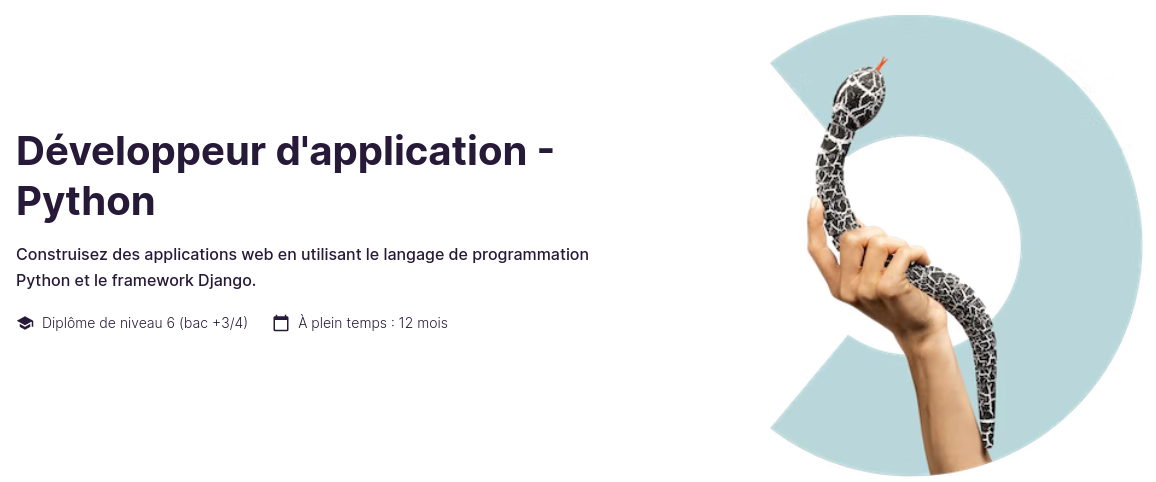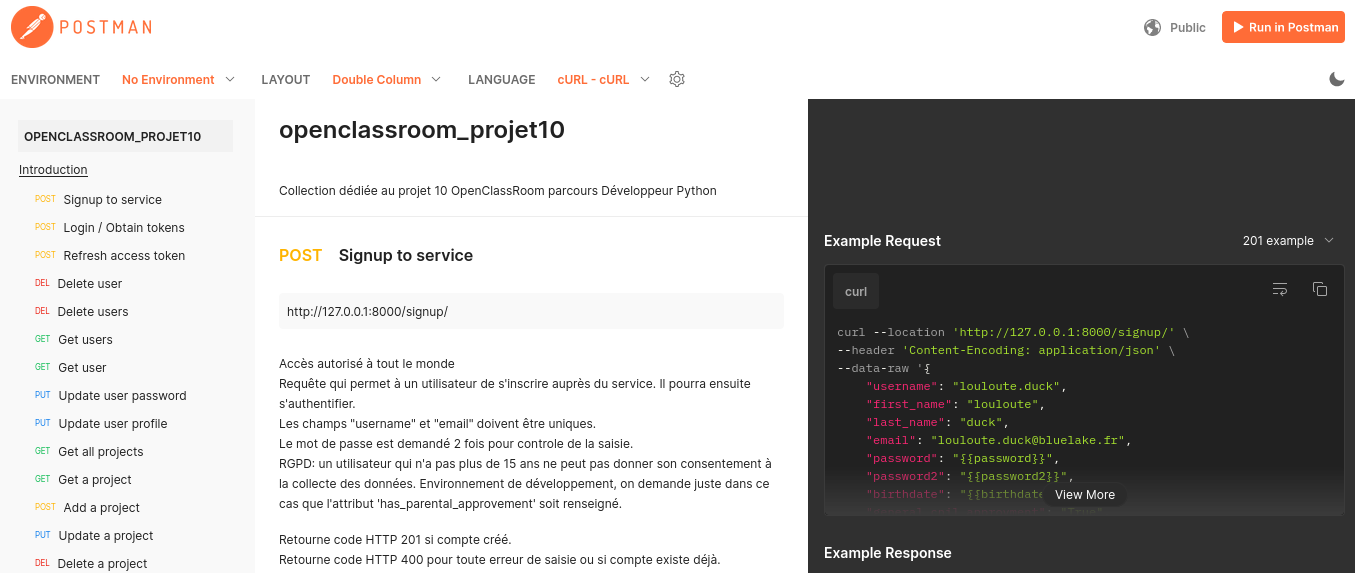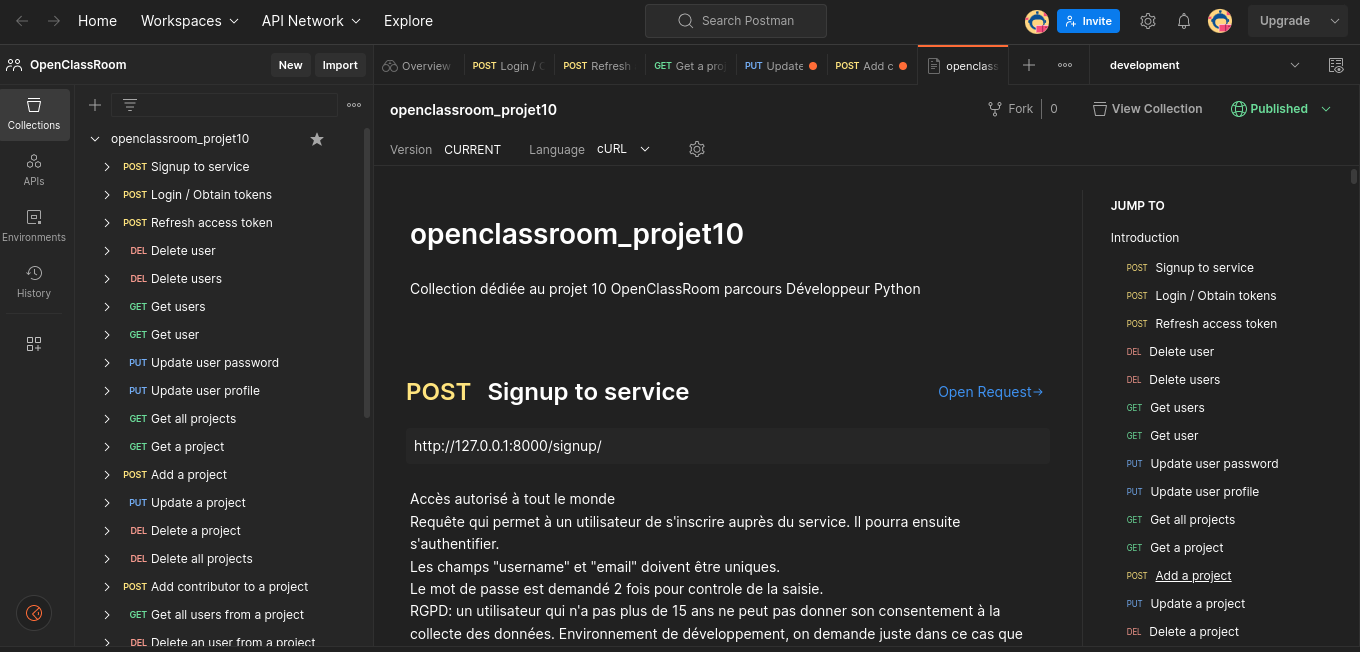OpenClassRoom - Parcours développeur Python
Develop an opened access RESTful API which permits to supervise issues from 4 thematics: front-end, back-end, Android, or iOS.
For each thematic you create a Project. For each ones, users can create issues and comments (as long as they are part of a project).
So main features :
- be able to create projetcs
- add /remove user(s) from a specific project
-,allow users to create issues and comments
- endpoints which allows the dialog with the API
Introduce all endpoints using Postman
Quickly describe the code and how you manage to respect OWASP and RGPD guidelines.
Introduce to a Postmand's API doc.
Implement a dependency manager, example: pipenv or poetry.
- Create API RESTful with Django REST.
- Securing an API with full respect of OWASP and RGPD guidelines.
- Document an application through Postman.
This REST API has a JWT tokens authentication mechanism implemented.
When you log to the application you will receive 2 tokens: an access one and a refresh one.
You will have to add the "access token" as a header in all your requests. Postman API documentation is below.
We set the "access token" with a 15 minutes lifetime validity. You will have to refresh your "access token".
Procedure to refresh it is describe below (as well in Postman API documentation).
Notice the application will prompt you when the token has expired.
The Postman API Doc should answer to any question about the basic usage.
Pay attention to the 'projects' and issues life cycles.
A 'project' can have the following status: Open, Archived, Canceled.
If you DELETE a 'project', as an author, which has no issues : 'project' will have status Canceled.
If you DELETE a 'project', as an author, which has at least 1 issue : 'project' will have status Archived.
Once project is archived or canceled, it can no more be updated or re-opened.
An issue can have the following status: To Do, In Progress, Finished.
Once project is finished, it can no more be updated or re-opened.
-
Clone the repository
git clone https://github.com/memphis-tools/oc_projet10_rest_framework.gitcd oc_projet10_rest_framework -
Setup a virtualenv : 2 possibilities offered here.
2.1 Legacy (you create your venv, source it and then install project's dependencies)
python -m venv envsource env/bin/activatepip install -U pippip install -r requirements.txt2.2 Poetry (you use poetry as a dependencie manager and as a venv builder)
https://python-poetry.org/docs/basic-usage/
This implies that you already have a Python interpreter and download the poetry package on your local machine:
pip install poetrypoetry config cache-dir ./.cache/pypoetry --localpoetry config virtualenvs.prompt oc_projet10poetry installpoetry updatesource $(poetry env info --path)/bin/activate -
Start the application : 2 possibilities offered here.
3.1 Start the application from scratch, run successively
python ./manage.py makemigrationspython ./manage.py migrateCreate a super user:
python ./manage.py shellby following these instructions :>>> from authentication.models import User >>> username="admin" >>> email="admin@localhost" >>> password="applepie94" >>> User.objects.create_superuser(username, email, password, birthdate="0001-01-01", general_cnil_approvement=True)python ./manage.py runserver3.2 Populate a development dummy database and then start the application
Notice the 3 dummy users username: donald.duck, daisy.duck, loulou.duck. Default password is: applepie94
python ./manage.py init_app_softdeskpython ./manage.py runserver -
Refresh your "access token"
To refresh, you just need to add a request POST to "token/refresh/" endpoint addressing your "refresh token".
You will then receive a new "access token". Please follow examples in the Postman API documentation.
-
Read the postman API documentation
Illustration
All run in a development environment
-
Test the project
To facilitate tests without updating the ACCESS_TOKEN_LIFETIME in settings file, you can use these instructions.
You will need first to create a virtual-env (with 'venv' or 'poetry') as describe above. Then:
export DJANGO_ENVIRONMENT=TESTecho $DJANGO_ENVIRONMENTpython ./manage.py makemigrationspython ./manage.py migrateBefore execute any test you should pay attention to the pytest.ini file.
To execute all the tests:
pytest tests -vorpytest tests -vsTo execute specific tests:
pytest -v tests/test_users.py,pytest -v tests/test_projects.py,pytest -v tests/test_issues.py,pytest -v tests/test_comments.pyOnce you ran it, unset the DJANGO_ENVIRONMENT
unset DJANGO_ENVIRONMENT





